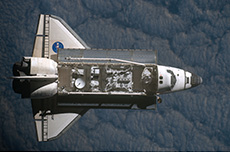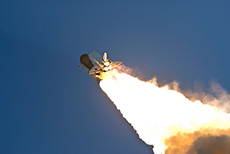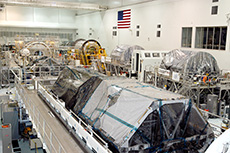Q. How did you feel watching the Kibo assembly missions?
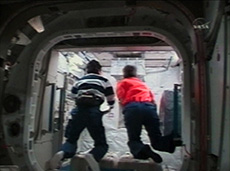
Astronaut Takao Doi (left): the first person to enter the ELM-PS (courtesy: NASA)
On the first Kibo assembly mission in March 2008, we launched the Experiment Logistics Module-Pressured Section (ELM-PS). Astronaut Takao Doi flew with it to attach it on ISS and to reconfigure it for flight. On the second mission, three months later, we launched the Pressurized Module and robotic arm. Akihiko Hoshide flew on this mission. Then, on the third mission, in July 2009, we launched the Exposed Facility and ELM Exposed Section, which was installed by Koichi Wakata. I was incredibly happy when Wakata, who had been selected as the first astronaut to work on assembling the ISS, finally completed the work on Kibo and brought this phase of the project to its conclusion.
Earlier, it was so emotional for us when the hatch to Kibo’s ELM-PS was first opened on orbit. It was a historic moment when, after 20 long years, one of our citizens entered into Japan’s first manned space facility. Head of NASA’s flight director office arranged for me to witness the moment from the ISS mission control room at NASA’s Johnson Space Center in Houston. Everyone around me started clapping when Takao Doi inside Kibo sent a message down to Earth. It was such a grand feeling. I can still remember that scene clearly in my mind.
Q. What sorts of difficulties were there faced on the way to completing Kibo?
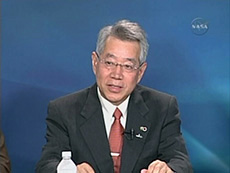
NASA press conference soon after the Pressurized Module was attached to the ISS (courtesy: NASA)
It took three flights to assemble Kibo, and in all three cases I was attending daily ISS management meetings in Houston while the shuttle was in orbit. Naturally there were flaws in the initial configurations of equipment set by NASA, Europe and Japan, so we determined in advance procedures to deal with various off-nominal cases. International cooperation on this was difficult.
It’s now been two years since we completed Kibo, and it has been operating smoothly, with no significant problems. All the initial flaws have now been fixed, but here’s an example of one problem that came up.
Soon after we attached the Pressurized Module, there was a problem with starting up its cooling system. When electricity feeds into the equipment, it emits heat, and we use water as a coolant. Pipes that circulate the coolant connect to the heat exchangers in Node 2 via jumper hoses, transferring heat to outside the station. Right after the jumper hoses were connected, we saw signs that air bubbles had gotten into coolant water and that the jumper should had not been filled with water. So JAXA engineering team investigate, based on ground-test data, and worked out a countermeasure in which we would momentarily increase the speed of the coolant circulation pump to remove the bubbles as quickly as possible. That worked – the problem was quickly solved. Our ground tests had modeled a variety of situations, and those efforts actually paid off this time.
We were also able to prevent some problems from occurring on Kibo in the first place. For example, during an earlier mission to assemble the European experiment module, the European control computer failed to communicate with NASA’s. It was fixed with modifications to the software, but this was a problem that could have happened when booting Kibo’s communications equipment too. The three organizations – Japan, the U.S. and Europe – shared information so that this problem wouldn’t happen on Kibo.
This sort of mission progress is reported daily at televised NASA press conferences, and when there was something about Japan then I would also attend. I appeared at dozens of press conferences over the course of the three assembly missions. Since people in Japan were also watching, I should make JAXA’s presence there. I was always nervous about taking questions of the American media specialized in space activities. One of the senior reporters who regularly attended told me after we completed Kibo assembly, “Japan has done well. Congratulations.” I remember that when I heard that, I felt pleased and rewarded for all the preparation we had done.

